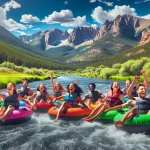McElmo Creek, a 70.1-mile-long tributary of the San Juan River, originates just east of Cortez in Montezuma County, Colorado. This picturesque creek flows through a diverse landscape, offering visitors a wealth of outdoor activities and cultural experiences.
In This Article
TL;DR
- Explore the diverse outdoor activities available around McElmo Creek, including hiking, camping, and fishing.
- Discover the fishing opportunities and species found in the creek, such as trout and bass.
- Learn about the ecological and cultural significance of the area, including its importance to local indigenous communities.
Exploring the Natural Beauty of McElmo Creek
Hiking and Trails
McElmo Creek is surrounded by a network of hiking trails that cater to various skill levels. The Sand Canyon Trail, located in the Canyons of the Ancients National Monument, is a popular choice for hikers. This 6-mile trail offers stunning views of the red rock cliffs and the opportunity to explore ancient ruins along the way. As you traverse the scenic landscape, keep an eye out for wildlife, such as mule deer, jackrabbits, and a variety of bird species.
Camping and Accommodations
Camping is an excellent option for those looking to immerse themselves in McElmo Creek’s natural beauty. The area offers several campgrounds, including the Sand Canyon Pueblo Campground, which provides basic amenities like picnic tables and fire rings. If you prefer more comfortable accommodations, nearby towns like Cortez and Dolores offer a range of lodging options, from cozy bed and breakfasts to modern hotels.
The Angler’s Paradise: Fishing in McElmo Creek
Understanding the Creek’s Ecosystem
McElmo Creek is home to a diverse array of fish species, thanks to its unique habitat and efforts to maintain its health and biodiversity. The creek’s flow increased after water was diverted from the Dolores River in 1889, resulting in new water flows from irrigation wastewater, canal leakage, and higher groundwater levels. This change in the ecosystem has created a thriving environment for various fish species.
Fishing Techniques and Tips
Anglers visiting McElmo Creek can enjoy a range of fishing techniques, including fly fishing and bait fishing. When selecting bait, consider using natural options like worms or insects, as well as artificial lures that mimic the prey of the fish species you’re targeting. Remember to obtain the necessary fishing licenses and adhere to catch-and-release guidelines to help preserve the creek’s fish populations.
The Cultural Tapestry of McElmo Creek
Historical Significance
McElmo Creek holds great historical significance, particularly for local indigenous communities. The area was once home to Ancestral Puebloan people, who built impressive cliff dwellings and mesa-top settlements. Visitors can explore nearby historical sites, such as the Sand Canyon Pueblo, to better understand the region’s rich cultural heritage. The Canyons of the Ancients National Monument Visitor Center and Museum is a must-visit for every archaeology and history buff. Its exhibits, research library, and special programs help shed light on the ancient culture of the Puebloan and other Native American peoples.
Local Events and Community
The communities surrounding McElmo Creek host various events and festivals throughout the year that celebrate the area’s natural beauty and cultural traditions. These gatherings provide an excellent opportunity for a visitor to engage with locals and learn more about the region’s history and contemporary life.
Adventure Sports and Recreation
Rock Climbing and Bouldering
The sandstone cliffs and rock formations near McElmo Creek offer exciting opportunities for rock climbing and bouldering enthusiasts. Local climbing guides and outfitters can provide information on the best routes and safety tips for exploring the area’s vertical landscapes.
Water Sports
While McElmo Creek itself may not be suitable for water sports due to its size and flow, nearby water bodies like McPhee Reservoir offer opportunities for kayaking, canoeing, and stand-up paddleboarding. Rental locations and guided tours are available for those looking to explore the region’s waterways.
FAQ Section
What types of fish can I expect to catch in McElmo Creek?
McElmo Creek is home to various fish species, including rainbow trout, brown trout, and bass. Anglers may also encounter catfish and carp in the creek’s waters.
Are there any permits required for outdoor activities in the McElmo Creek area?
Fishing in McElmo Creek requires a valid Colorado fishing license, which can be obtained online or at local sporting goods stores. Some campgrounds and recreation areas may also require permits or reservations, so checking with the managing agency before your visit is best.
What are the best times of year to visit McElmo Creek for outdoor activities?
The best times to visit McElmo Creek for outdoor activities are spring through fall. Summer months offer warm weather and long days for hiking and camping, while spring and fall provide comfortable temperatures and fewer crowds.
How can I learn about the cultural history of McElmo Creek?
Visitors can learn about McElmo Creek’s cultural history by exploring nearby historical sites, such as the Canyons of the Ancients National Monument, its Visitor Center and Museum, and the Anasazi Heritage Center. These locations offer exhibits, guided tours, and educational programs that delve into the area’s rich indigenous history.
What are some safety considerations when engaging in outdoor activities at McElmo Creek?
When enjoying outdoor activities at McElmo Creek, it’s essential to be prepared for changing weather conditions and to bring adequate water, food, and sun protection. Be aware of wildlife in the area, and always let someone know your planned route and expected return time before setting out on a hike or camping trip.






